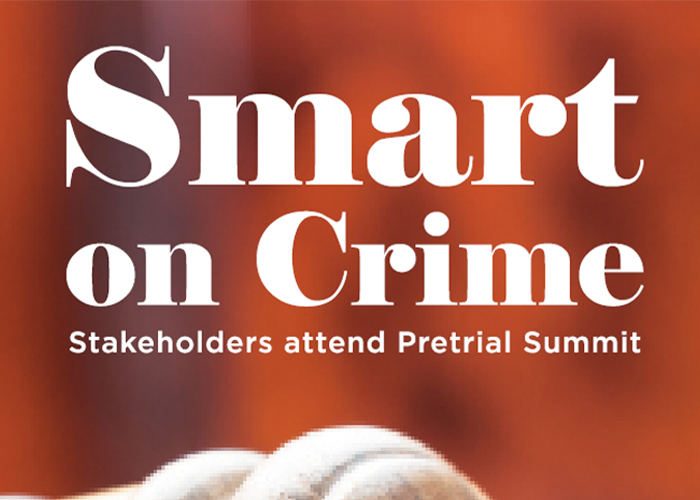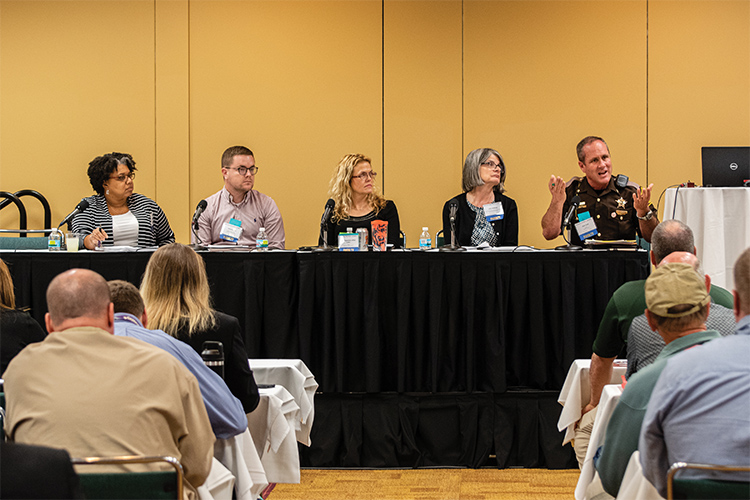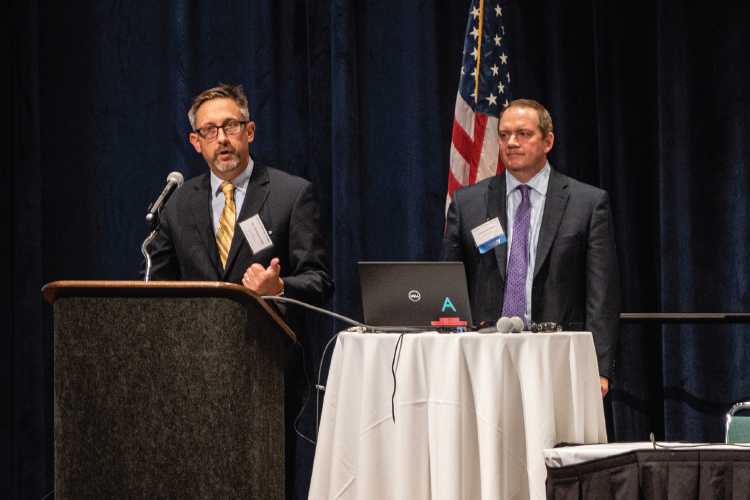By Mary Kay Hudson, Executive Director | Office of Court Services
David Sexton, Intern | Office of Communication, Education & Outreach
 Preparing for Criminal Rule 26
Preparing for Criminal Rule 26
In anticipation of January 1, 2020, when Indiana Criminal Rule 26 goes into effect, more than 700 criminal justice stakeholders from nearly every county gathered at the Indiana Pretrial Summit. Summit attendees convened on October 4, 2019 at the Indiana Convention Center—with most counties represented by whole teams of stakeholders—to learn about best practices in pretrial release and develop localized strategies.
The foundation for this event was laid in 2014 when the Supreme Court established a pretrial program. Since then, 11 counties have worked to develop and implement legal and evidence-based practices in partnership with Indiana’s Evidence Based Decision Making Initiative Policy Team and the EBDM Pretrial Work Group.
Opening the Summit, Chief Justice Loretta Rush said, “pretrial means keeping the right people in jail for the right reasons by using informed decision-making.” She then welcomed Representative Greg Steuerwald (House District 40), who authored Indiana’s criminal code reform legislation. While acknowledging the complexity of the issue, Representative Steuerwald stressed that some sheriffs face overcrowding issues that could be alleviated if jails housed fewer pretrial detainees.
Prosecuting Attorney Ken Cotter (St. Joseph County), a pretrial pilot participant, shared with attendees that while he had concerns at the start of the project, he now supports using evidence-based assessment tools. Judge Mary Ellen Diekhoff (Monroe Circuit Court) highlighted disparities in her county’s prior practice of relying on a charge-based bail schedule to guide pretrial release decisions.
Beyond Criminal Rule 26: The Three M’s
While Criminal Rule 26 urges courts to consider pretrial risk assessment results when determining release conditions, the Summit focused on a broader range of evidence-based pretrial practices. Attendees learned about Indiana’s legal framework for bail and pretrial release, evidence-based supervision strategies, and the roles of defense counsel and the state at initial hearings.
Judge Mark Spitzer (Grant Circuit Court) highlighted the complexity of the pretrial process, including shifting away from a post-conviction approach used in probation supervision to focus on the “Three M’s” governing pretrial practice: maximize release, maximize appearance, and maximize public safety. During the Summit opening he noted, “pretrial is not probation.”
Collaboration is Key

A consistent theme of the Summit was collaboration. Communication and partnership among all criminal justice stakeholders is key to success. In keeping with that theme, counties brought teams of up to 12 local justice professionals representing their unique roles within the pretrial system: law enforcement officers, sheriffs, jail commanders, pretrial officers, prosecutors, defense counsel, and judges.
One Summit participant noted, “I thought it was good to hear the perspective of the sheriff, judge, and pretrial supervision officers on the same panel.” Another Summit attendee noted, “It was interesting getting the perspective of prosecutors, as they have to deal with these evidence-based changes to the system.Making the public feel that they are safe while treating defendants with a presumption of innocence can be a complicated task.”
Pretrial Risk and Pretrial Risk Assessments
Indiana has used the Indiana Risk Assessment System Community Supervision Tool to inform sentencing and probation decisions since 2010. Under Criminal Rule 26, counties will use the IRAS Pretrial Assessment Tool to assess risk of failure during the pretrial period. At the Summit, Dr. Brad Ray, Director of the Center for Behavioral Health and Justice at Wayne State University, provided an overview of pretrial risk assessment and discussed the importance of incorporating risk assessment results into the pretrial decision process:
The use of an empirically based risk assessment tool to determine the likelihood of pretrial misconduct is an evidence-based practice.
Dr. Ray and a team of researchers have been evaluating Indiana’s pretrial pilot project since its inception. He noted that preliminary research results in the pilot sites suggest “moderate to strong” predictive accuracy in measuring pretrial misconduct, including failure to appear and re-arrest.
He noted that data collection and evaluation efforts are ongoing to examine whether use of pretrial risk assessments improves fairness of pretrial decision making and to determine which supervision practices produce the best outcomes. While Dr. Ray highlighted the value of using risk assessment to guide pretrial decisions, he was clear in pointing out that pretrial risk assessment is designed to inform—not replace—judicial decision making. He also stressed the importance of administering the tool with fidelity by stating, “even a validated risk assessment tool will not produce accurate results if it is not used correctly.”
Local and State Perspective
To highlight Indiana’s local and state pretrial partnership, Justice Steven David, chair of Indiana’s Evidence Based Decision Making Initiative Policy Team, moderated a panel of local and state stakeholders to discuss progress, challenges, and what comes next. Prosecuting attorney Loren Delp (Hendricks County) encouraged fellow prosecutors to keep an open mind about the process and to reach out to the pilot counties for information and support.
Bernice Corley, Indiana Public Defender Council Executive Director, advised that the Council will provide training opportunities to help defense counsel better understand their role during initial hearings.
Chris Naylor, Indiana Prosecuting Attorneys Council Executive Director, noted that the state is committed to provide technical assistance opportunities to counties as they develop pretrial release programs. The Indiana EBDM Policy Team is seeking ways to support local implementation through increased training and funding for pretrial services.
Closing the Day

Justice Steven David, Justice Christopher Goff, and Chris Naylor closed out the Summit with reflections on the day and encouragement to counties for 2020 and beyond. Echoing Chief Justice Rush’s opening remarks, Justice Goff reminded the participants that “pretrial reform does not mean that Indiana has chosen to be soft on crime…it means Indiana has chosen to be smart on crime.”